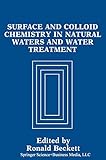Surface and colloid chemistry in natural waters and water treatment [Libro electrónico] / edited by Ronald Beckett
Beckett, Ronald [editor].
Tipo de material: Libro
en línea Editor: New York, New York, United States: Plenum Press, c1990Descripción: viii, 159 páginas : ilustraciones ; 26 centímetros.ISBN: 030643802X; 9781489925121 (Print); 9781489925107 (Online).Tema(s): Surface chemistry -- Congresses | Colloids -- Congresses | Water chemistry -- CongressesNota de acceso: Disponible para usuarios de ECOSUR con su clave de acceso Nota de bibliografía: Incluye bibliografía e índice: páginas 155-159 Número de sistema: 55598Contenidos:Mostrar
Resumen:
Libro
en línea Editor: New York, New York, United States: Plenum Press, c1990Descripción: viii, 159 páginas : ilustraciones ; 26 centímetros.ISBN: 030643802X; 9781489925121 (Print); 9781489925107 (Online).Tema(s): Surface chemistry -- Congresses | Colloids -- Congresses | Water chemistry -- CongressesNota de acceso: Disponible para usuarios de ECOSUR con su clave de acceso Nota de bibliografía: Incluye bibliografía e índice: páginas 155-159 Número de sistema: 55598Contenidos:Mostrar
Resumen:| Tipo de ítem | Biblioteca actual | Colección | Signatura | Estado | Fecha de vencimiento | Código de barras |
|---|---|---|---|---|---|---|
| Libros | Biblioteca Electrónica Recursos en línea (RE) | Acervo General | Recurso digital | ECO400555985682 |
Incluye bibliografía e índice: páginas 155-159
Chapter 1. Processes in natural waters.. 1. The surface chemistry of humic substances in aquatic systems.. 2. Microbial processes occurring at surfaces.. 3. Photochemistry of colloids and surfaces in natural waters and water treatment.. 4. Kinetics and mechanisms of iron colloid aggregation in estuaries.. 5. The generation of suspended sediment in rivers and streams.. 6. Application of the uranium decay series to a study of ground water colloids.. Chapter 2. Water treatment processes.. 7. Water treatment technology in Australia.. 8. The role of surface and colloid chemistry in the SIROFLOC process.. 9. Coagulation and flocculation - destabilizing practices? (with particular reference to metal ion coagulants.. 10. Enhanced biological removal of phosphorus from wastewater.. 11. Some effects of dam destratification upon manganese speciation.. Index
Disponible para usuarios de ECOSUR con su clave de acceso
The discipline of surface and colloid chemistIy has experienced a considerable resurgence since the early sixties. This perhaps reflects a growing realisation of the wide applicability of modern colloid and surface theory to many important industrial, medical and environmental problems. This increased activity has resulted in a very complex and at times even confusing area of science being consolidated within a firm theoretical framework. The clearer insights gained into the underlying principles have no doubt acted in an autocatalytic manner to stimulate further interest in an expanding range of applications. A good example in the area of environmental chemistry has been the realization of the important role played by colloidal material and surface interactions in natural biogeochemical processes that has been the subject of increasing attention over the last few decades. This is well illustrated by the numerous studies carried out to elucidate the speciation, toxicity, transport and fate of pollutants in aquatic systems. In the vast majority cases these have clearly implicated some involvement of an aSSOciation between the of pollutant (e. g. trace metal, toxic organic compound or nutrient) and a colloidal component (e. g. particle, humic substance, foam). In order to understand these interactions fully and their effect on pollutant mobility it is important to develop a full appreciation of the surface chemistry of these complex systems. Australian SCientists have long been prominent in the area of colloid and surface chemistry particularly dUring the latter half of this century. eng
Disponible en línea
Disponible en formato PDF
Subscripción a ELSEVIER 26 de diciembre del 2013
